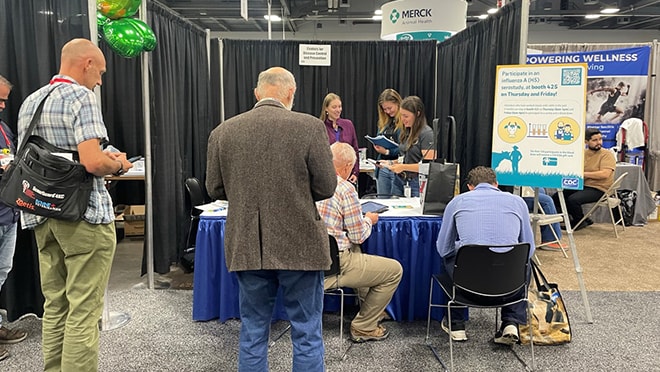What to know
A CDC team of epidemiologists, veterinarians, phlebotomists, and health communication specialists worked with the Ohio Department of Health (ODH) and the American Association of Bovine Practitioners (AABP) to conduct a serosurvey to assess past exposure to influenza A(H5) viruses among a national network of veterinarians and other veterinary professionals at the AABP annual conference in Columbus, Ohio.

CDC Update
September 20, 2024 – Last week, CDC and ODH staff at the AABP conference enrolled about 150 attendees who have worked closely with cattle in the past three months. Participants included veterinarians, credentialed veterinary technicians, and veterinary students who practiced in 45 U.S. states. AABP attendees expressed excitement at the opportunity to participate and inform the body of science around influenza A(H5) in the United States, especially risks of infection among veterinary professionals. They also shared their experiences of working with cattle during the multi-state H5 bird flu outbreak in dairy cows to help further contribute to the practical understanding of this disease on the ground.
Veterinarians and other veterinary professionals play a key role in implementing a One Health approach in this H5 bird flu response. The goal of this serosurvey is to better understand the extent of prior influenza A(H5) infections among people who work closely with cattle and the current risk of infection associated with occupational exposures in the bovine veterinary practitioner community.
Participants completed an online survey about animal exposures, personal protective equipment (PPE) worn around these animals, seasonal influenza vaccination, and attitudes toward a potential influenza A(H5) vaccine, if one were to be authorized. A trained team of phlebotomists collected blood samples that will be studied to look for antibodies to influenza A(H5) viruses, which would indicate a prior infection with H5 bird flu. CDC epidemiologists will assess associated risk factors in people whose samples test positive. They also asked whether the person had respiratory or flu-like symptoms since January of this year, and whether they sought care or received treatment for that illness.
Through community engagement and meeting people where they are, the CDC and ODH team were able to engage the AABP community, educate about the current H5 bird flu outbreak, and achieve high participation in this serosurvey. The strong collaboration among these three organizations will continue in the coming weeks, including writing up and disseminating the results of this serosurvey. Aggregate results will be shared with AABP members and will be disseminated to other professional groups, in addition to the public, to help veterinarians and other veterinary professionals understand the risk of exposures to cattle and what they can do to protect themselves, other people, and their animals.
